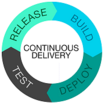Upgrade & Secure Your Future with DevOps, SRE, DevSecOps, MLOps!
We spend hours on Instagram and YouTube and waste money on coffee and fast food, but won’t spend 30 minutes a day learning skills to boost our careers.
Master in DevOps, SRE, DevSecOps & MLOps!
Learn from Guru Rajesh Kumar and double your salary in just one year.
Source:- cioreview.com
To meet business needs faster, many organizations are eager to embrace continuous delivery and gain the ability to rapidly and repeatedly push out software enhancements. By applying this methodology, IT teams can improve software systems faster, increasing satisfaction for end users. It is a competitive advantage that allows enterprises to move at the speed of business and meet the expectations of their audience.
At Vivint Solar, continuous delivery is key to our ability to succeed in a competitive, increasingly crowded market. The residential solar industry is one of the fastest growing in the country, but it is also an emerging, maturing industry with rapid changes. Each day brings a new development, whether it is expanding to a new market, introducing a new financing option in an existing market or adjusting our offerings in response to new regulations.
As chief technology and information officer, I am responsible for managing our ever-changing list of priorities efficiently. Applying our collective learnings and experience, our team has developed a software delivery philosophy called “the first finish line.” The term implies a continuous journey, and that is no coincidence. With the first finish line, we’re not running a marathon—we’re running the first 100 meters repeatedly.
Depending on how priorities shift, resources may need to be allocated elsewhere, requiring a collaborative mindset
Under this approach, our work is guided by the following questions: What do your users need most urgently, and how quickly can you deliver it to them? This thinking shapes all aspects of our work and orients our approach around a list of priorities that is constantly changing.
Indeed, being nimble and agile is key to succeeding with this approach. You cannot be tied to reaching a specific finish line because you may be surprised by the arrival of a new race you and your team have to run first. The finish line is never static because business is never static. To run the race effectively, you need solid capabilities in resource management, a healthy dose of flexibility, a common development stack, an efficient DevOps model, and a mindset for future architectures built for change.
While this can seem like chaos to the outsider, this approach, when executed properly, is grounded in control. Setting a vision provides a North Star for your team as it executes, but it’s also important to be adaptable to that vision. You shouldn’t be rewriting your entire playbook every day, but you should embrace the realities of your industry and the need to react quickly.
Of course, speed can come at the sacrifice of quality. But with this approach, we’ve found the opposite to be true. Since you may only get one shot at crossing that finish line, you want to run a great race. When priorities are continually evolving, you know there is a strong likelihood you may never have the opportunity to reach the second finish line for that specific project. Knowing that release No. 2 may never occur encourages your team to approach the task at hand with a greater sense of purpose and focus. We have seen over and over again that the MVP (Minimum Viable Product) becomes the product that stays for long periods of time because business priorities shift to the next big race.
Racing to the first finish line naturally lends itself to work in smaller increments as opposed to large-scale projects — think feature sets instead of full websites. It requires you to refine the execution in the interim while keeping long-term goals in sight. Working together as a team is also critical for success with this approach. Depending on how priorities shift, resources may need to be allocated elsewhere, requiring a collaborative mindset.
Without this approach, we could not succeed at Vivint Solar, where a major source of our growth is from our direct-to-home salesforce. We have sales professionals located in the 15 states in which we operate. Using analytics, our sales teams identify neighborhoods in their markets with a high likelihood of adopting rooftop solar to increase their energy independence. Because these interactions with a Vivint Solar representative are how most consumers will experience our brand for the first time, it is our responsibility to ensure we empower this mobile workforce with the tools they need to deliver the best possible experience.
Our sales pros use tablets in the field to demonstrate the benefits of solar power and enter into agreements with customers. Because they are on the frontlines, they cannot wait months for updates to our sales-facing app to take place. If there is a new sales offering or even a software bug preventing them from closing sales agreements in the app, this issue instantly rises to the top of our priority list, and we race to reach that first finish line.
The continual improvement of software performance is a prerequisite for competing in any industry, but particularly for those in industries that are fluid and fast moving. By adopting this approach in your organization, you will be well positioned to reap the benefits of continually reaching the first finish line.

 Starting: 1st of Every Month
Starting: 1st of Every Month  +91 8409492687 |
+91 8409492687 |  Contact@DevOpsSchool.com
Contact@DevOpsSchool.com